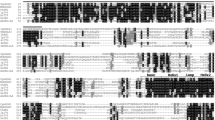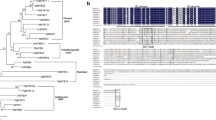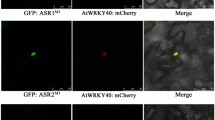Key message
A novel R2R3 MYB transcription factor PtrMYB57 interacted with bHLH131 and PtrTTG1 to form the MBW complex and negatively regulated the biosynthesis of both anthocyanins and PAs in poplar.
Abstract
R2R3-MYB transcription factors (TFs) are important regulators of secondary metabolite biosynthesis in woody species. A series of R2R3-MYB TFs involved in anthocyanin and proanthocyanidin (PA) biosynthesis have been identified in poplar. In this study, we report the identification and characterization of a subgroup 4 MYB member PtrMYB57, which contains a repressor domain (LxLxL) at the C-terminal end. PtrMYB57 encodes an R2R3 MYB protein localized in the nucleus and is predominantly expressed in mature leaves. Transgenic poplar overexpressing PtrMYB57 showed a reduction in anthocyanin and PA accumulation compared to wild-type plants. By contrast, a high anthocyanin and PA phenotype was observed in Ptrmyb57 mutants generated by the CRISPR/Cas9 system. Furthermore, transient expression assays revealed that PtrMYB57 interacted with bHLH131 (bHLH) and PtrTTG1 (WDR) to form the MBW complex and bound to the flavonoid gene promoters, leading to inhibition of these promoters. Taken together, our results suggest that PtrMYB57 plays a negative role in the regulation of anthocyanin and PA biosynthesis in poplar.







Similar content being viewed by others
References
Abrahams S, Lee E, Walker AR et al (2003) The Arabidopsis TDS4 gene encodes leucoanthocyanidin dioxygenase (LDOX) and is essential for proanthocyanidin synthesis and vacuole development. Plant J 35(5):624–636
Aharoni A, De Vos CH, Wein M (2001) The strawberry FaMYB1 transcription factor suppresses anthocyanin and flavonol accumulation in transgenic tobacco. Plant J 28(3):319–332
Albert NW (2015) Subspecialization of R2R3-MYB repressors for anthocyanin and proanthocyanidin regulation in Forage Legumes. Front Plant Sci 6:1165
Albert NW, Davies KM, Lewis DH et al (2014) A conserved network of transcriptional activators and repressors regulates anthocyanin pigmentation in eudicots. Plant Cell 26:962–980
Altschul SF, Gish W, Miller W (1990) Basic local alignment search tool. J Mol Biol 215(3):403–410
An XH, Tian Y, Chen KQ (2015) MdMYB9 and MdMYB11 are involved in the regulation of the JA-induced biosynthesis of anthocyanin and proanthocyanidin in apples. Plant Cell Physiol 56(4):650–662
Barbehenn RV, Constabel CP (2011) Tannins in plant-herbivore interactions. Phytochemistry 72(13):1551–1565
Baudry A, Heim MA, Dubreucq B et al (2004) TT2, TT8, and TTG1 synergistically specify the expression of BANYULS and proanthocyanidin biosynthesis in Arabidopsis thaliana. Plant J 39(3):366–380
Bogs J, Jaffé FW, Takos AM (2007) The grapevine transcription factor VvMYBPA1 regulates proanthocyanidin synthesis during fruit development. Plant Physiol 143(3):1347–1361
Borevitz JO, Xia Y, Blount J (2000) Activation tagging identifies a conserved MYB regulator of phenylpropanoid biosynthesis. Plant Cell 12(12):2383–2393
Cavallini E, Matus JT, Finezzo L (2015) The phenylpropanoid pathway is controlled at different branches by a set of R2R3-MYB C2 repressors in grapevine. Plant Physiol 167(4):1448–1470
Chen S, Songkumarn P, Liu J (2009) A versatile zero background T-vector system for gene cloning and functional genomics. Plant Physiol 150(3):1111–1121
Cho JS, Nguyen VP, Jeon HW (2016) Overexpression of PtrMYB119, a R2R3-MYB transcription factor from Populus trichocarpa, promotes anthocyanin production in hybrid poplar. Tree Physiol 36(9):1162–1176
Colquhoun TA, Kim JY, Wedde AE (2010) PhMYB4 fine-tunes the floral volatile signature of Petunia × hybrida through PhC4H. J Exp Bot 62(3):1133–1143
Cone KC, Burr FA, Burr B (1986) Molecular analysis of the maize anthocyanin regulatory locus C1. Proc Natl Acad Sci 83(24):9631–9635
Cos P, De Bruyne T, Hermans N et al (2004) Proanthocyanidins in health care: current and new trends. Curr Med Chem 11(10):1345–1359
Czemmel S, Stracke R, Weisshaar B (2009) The grapevine R2R3-MYB transcription factor VvMYBF1 regulates flavonol synthesis in developing grape berries. Plant Physiol 151(3):1513–1530
Davies KM, Albert NW, Schwinn KE (2012) From landing lights to mimicry: the molecular regulation of flower colouration and mechanisms for pigmentation patterning. Funct Plant Biol 39(8):619–638
Deluc L, Barrieu F, Marchive C (2006) Characterization of a grapevine R2R3-MYB transcription factor that regulates the phenylpropanoid pathway. Plant Physiol 140(2):499–511
Deluc L, Bogs J, Walker AR (2008) The transcription factor VvMYB5b contributes to the regulation of anthocyanin and proanthocyanidin biosynthesis in developing grape berries. Plant Physiol 147(4):2041–2053
Dixon RA, Lamb CJ, Masoud S, Sewalt VJ, Paiva NL (1996) Metabolic engineering: prospects for crop improvement through the genetic manipulation of phenylpropanoid biosynthesis and defense responses—a review. Gene 179:61–71
Dixon RA, Xie DY, Sharma SB (2005) Proanthocyanidins—a final frontier in flavonoid research? New Phytol 165:9–28
Engler C, Gruetzner R, Kandzia R (2009) Golden gate shuffling: a one-pot DNA shuffling method based on type IIs restriction enzymes. PLoS One 4(5):e5553
Espley RV, Hellens RP, Putterill J (2007) Red colouration in apple fruit is due to the activity of the MYB transcription factor, MdMYB10. Plant J 49(3):414–427
Fan D, Liu T (2015) Li C (2015) Efficient CRISPR/Cas9-mediated targeted mutagenesis in Populus in the first generation. Sci Rep 5:12217
Fornalé S, Lopez E, Salazar-Henao JE (2014) AtMYB7, a new player in the regulation of UV-sunscreens in Arabidopsis thaliana. Plant Cell Physiol 55(3):507–516
Gould KS, McKelvie J, Markham KR (2002) Do anthocyanins function as antioxidants in leaves? Imaging of H2O2 in red and green leaves after mechanical injury. Plant, Cell Environ 25:1261–1269
Harborne JB, Williams CA (2000) Advances in flavonoid research since 1992. Phytochemistry 55:481–504
Huang YF, Vialet S, Guiraud JL et al (2014) A negative MYB regulator of proanthocyanidin accumulation, identified through expression quantitative locus mapping in the grape berry. New Phytol 201(3):795–809
Jefferson RA (1987) Assaying chimeric genes in plants: the GUS gene fusion system. Plant Mol Biol Rep 5(4):387–405
Jia Z, Gou J, Sun Y (2010) Enhanced resistance to fungal pathogens in transgenic Populus tomentosa Carr. by overexpression of an nsLTP-like antimicrobial protein gene from motherwort (Leonurus japonicus). Tree Physiol 30(12):1599–1605
Jin H, Cominelli E, Bailey P, Parr A (2000) Transcriptional repression by AtMYB4 controls production of UV-protecting sunscreens in Arabidopsis. EMBO J 19(22):6150–6161
Kagale S, Rozwadowski K (2011) EAR motif-mediated transcriptional repression in plants: an underlying mechanism for epigenetic regulation of gene expression. Epigenetics 6(2):141–146
Kagale S, Links MG, Rozwadowski K (2010) Genome-wide analysis of ethylene-responsive element binding factor-associated amphiphilic repression motif-containing transcriptional regulators in Arabidopsis. Plant Physiol 152(3):1109–1134
Koes R, Verweij W, Quattrocchio F (2005) Flavonoids: a colorful model for the regulation and evolution of biochemical pathways. Trends Plant Sci 10(5):236–242
Kranz HD, Denekamp M, Greco R, Jin H, Leyva A, Meissner RC, Petroni K, Urzainqui A, Bevan M, Martin C et al (1998) Towards functional characterisation of the members of the R2R3-MYB gene family from Arabidopsis thaliana. Plant J 16(2):263–276
Kraus TEC, Yu Z, Preston CM et al (2003) Linking chemical reactivity and protein precipitation to structural characteristics of foliar tannins. J Chem Ecol 29(3):703–730
Landi M, Guidi L, Pardossi A, Tattini M, Gould KS (2014) Photoprotection by foliar anthocyanins mitigates effects of boron toxicity in sweet basil (Ocimum basilicum). Planta 240(5):941–953
Li YY, Mao K, Zhao C (2012) MdCOP1 ubiquitin E3 ligases interact with MdMYB1 to regulate light-induced anthocyanin biosynthesis and red fruit coloration in apple. Plant Physiol 160(2):1011–1022
Lin-Wang K, Bolitho K, Grafton K (2010) An R2R3 MYB transcription factor associated with regulation of the anthocyanin biosynthetic pathway in Rosaceae. BMC Plant Biol 10(1):1
Ma X, Zhang Q, Zhu Q (2015) A robust CRISPR/Cas9 system for convenient, high-efficiency multiplex genome editing in monocot and dicot plants. Mol Plant 8(8):1274–1284
Marles MAS, Gruber MY, Scoles GJ, Muir AD (2003) Pigmentation in the developing seed coat and seedling leaves of Brassica carinata is controlled at the dihydroflavonol reductase locus. Phytochemistry 62(5):663–672
Mellway RD, Tran LT, Prouse MB et al (2009) The wound-, pathogen-, and ultraviolet B-responsive MYB134 gene encodes an R2R3 MYB transcription factor that regulates proanthocyanidin synthesis in poplar. Plant Physiol 150(2):924–941
Mol J, Grotewold E, Koes R (1998) How genes paint flowers and seeds. Trends Plant Sci 3(6):212–217
Nemie-Feyissa D, Olafsdottir SM, Heidari B, Lillo C (2014) Nitrogen depletion and small R3-MYB transcription factors affecting anthocyanin accumulation in Arabidopsis leaves. Phytochemistry 98:34–40
Nesi N, Jond C, Debeaujon I (2001) The Arabidopsis TT2 gene encodes an R2R3 MYB domain protein that acts as a key determinant for proanthocyanidin accumulation in developing seed. Plant Cell 13(9):2099–2114
Pang YZ, Peel GJ, Wright E et al (2007) Early steps in proanthocyanidin biosynthesis in the model legume Medicago truncatula. Plant Physiol 145(3):601–615
Paolocci F, Robbins MP, Passeri V (2010) The strawberry transcription factor FaMYB1 inhibits the biosynthesis of proanthocyanidins in Lotus corniculatus leaves. J Exp Bot 62(3):1189–1200
Peters DJ, Constabel CP (2002) Molecular analysis of herbivore-induced condensed tannin synthesis: cloning and expression of dihydroflavonol reductase from trembling aspen (Populus tremuloides). Plant J 32(5):701–712
Pietta PG (2000) Flavonoids as antioxidants. J Nat Prod 63:1035–1042
Porebski S, Bailey LG, Baum BR (1997) Modification of a CTAB DNA extraction protocol for plants containing high polysaccharide and polyphenol components. Plant Mol Biol Rep 15(1):8–15
Preston J, Wheeler J, Heazlewood J (2004) AtMYB32 is required for normal pollen development in Arabidopsis thaliana. Plant J 40(6):979–995
Qin G, Ma Z, Zhang L (2007) Arabidopsis AtBECLIN1/AtAtg6/AtVps30 is essential for pollen germination and plant development. Cell Res 17(3):249–263
Quattrocchio F, Verweij W, Kroon A et al (2006) PH4 of petunia is an R2R3 MYB protein that activates vacuolar acidification through interactions with basic-helix-loop-helix transcription factors of the anthocyanin pathway. Plant Cell 18(5):1274–1291
Rabino I, Mancinelli AL (1986) Light, temperature, and anthocyanin production. Plant Physiol 81(3):922–924
Sadowski I, Ma J, Triezenberg S (1988) GAL4-VP16 is an unusually potent transcriptional activator. Nature 335(6190):563–564
Shirley BW, Kubasek WL, Storz G, Bruggemann E, Koornneef M, Ausubel FM, Goodman HM (1995) Analysis of Arabidopsis mutants deficient in flavonoid biosynthesis. Plant J 8:659–671
Sparkes IA, Runions J, Kearns A, Hawes C (2006) Rapid, transient expression of fluorescent fusion proteins in tobacco plants and generation of stably transformed plants. Nat Protoc 1:2019–2025
Takos AM, Jaffe FW et al (2006) Light induced expression of a MYB gene regulates anthocyanin biosynthesis in red apples. Plant Physiol 142(3):1216–1232
Tamagnone L, Merida A, Parr A (1998) The AmMYB308 and AmMYB330 transcription factors from Antirrhinum regulate phenylpropanoid and lignin biosynthesis in transgenic tobacco. Plant Cell 10(2):135–154
Teng S, Keurentjes J, Bentsink L, Koornneef M, Smeekens S (2005) Sucrose-specific induction of anthocyanin biosynthesis in Arabidopsis requires the MYB75/PAP1 gene. Plant Physiol 139:1840–1852
Vanderauwera S, Zimmermann P, Rombauts S (2005) Genome-wide analysis of hydrogen peroxide-regulated gene expression in Arabidopsis reveals a high light-induced transcriptional cluster involved in anthocyanin biosynthesis. Plant Physiol 139(2):806–821
Walker AR, Lee E, Bogs J et al (2007) White grapes arose through mutation of two similar and adjacent regulatory genes. Plant J 49(5):772–785
Weisshaar B, Jenkins GI (1998) Phenylpropanoid biosynthesis and its regulation. Curr Opini Plant Biol 1:251–257
Winkel-Shirley B (2001) Flavonoid biosynthesis: a colorful model for genetics, biochemistry, cell biology, and biotechnology. Plant Physiol 126:485–493
Xie DY, Sharma SB, Paiva NL et al (2003) Role of anthocyanidin reductase, encoded by BANYULS in plant flavonoid biosynthesis. Science 299(5605):396–399
Xu F, Cai R, Cheng S et al (2008) Molecular cloning, characterization and expression of phenylalanine ammonialyase gene from Ginkgo biloba. Afr J Biotechnol 7(6):721–729
Xu W, Grain D, Bobet S et al (2014) Complexity and robustness of the flavonoid transcriptional regulatory network revealed by comprehensive analyses of MYB–bHLH–WDR complexes and their targets in Arabidopsis seed. New Phytol 202:132–144
Yoshida K, Ma D, Constabel CP (2015) The MYB182 protein down-regulates proanthocyanidin and anthocyanin biosynthesis in poplar by repressing both structural and regulatory flavonoid genes. Plant Physiol 167(3):693–710
Yuan L, Wang L, Han Z, Jiang Y, Zhao L, Liu H, Yang L, Luo K (2012) Molecular cloning and characterization of PtrLAR3, a gene encoding leucoanthocyanidin reductase from Populus trichocarpa, and its constitutive expression enhances fungal resistance in transgenic plants. J Exp Bot 63:2513–2524
Zaragoza MV, Lewis LE, Sun G (2004) Identification of the TBX5 transactivating domain and the nuclear localization signal. Gene 330:9–18
Zhu HF, Fitzsimmons K, Khandelwal A, Kranz RG (2009) CPC, a single-repeat R3 MYB, is a negative regulator of anthocyanin biosynthesis in Arabidopsis. Mol Plant 2:790–802
Zhu QL, Yang ZF, Zhang QY (2014) Robust multi-type plasmid modifications based on isothermal in vitro recombination. Gene 548(1):39–42
Acknowledgements
This work was supported by the National Natural Science Foundation of China (31370672, 31500216, and 31500544) and the “One Hundred Talents Program” of the Chinese Academy of Sciences.
Author information
Authors and Affiliations
Corresponding author
Ethics declarations
Conflict of interest
We declare that we have no conflict of interest.
Additional information
Communicated by Qiao Zhao.
Electronic supplementary material
Below is the link to the electronic supplementary material.
Rights and permissions
About this article
Cite this article
Wan, S., Li, C., Ma, X. et al. PtrMYB57 contributes to the negative regulation of anthocyanin and proanthocyanidin biosynthesis in poplar. Plant Cell Rep 36, 1263–1276 (2017). https://doi.org/10.1007/s00299-017-2151-y
Received:
Accepted:
Published:
Issue Date:
DOI: https://doi.org/10.1007/s00299-017-2151-y




